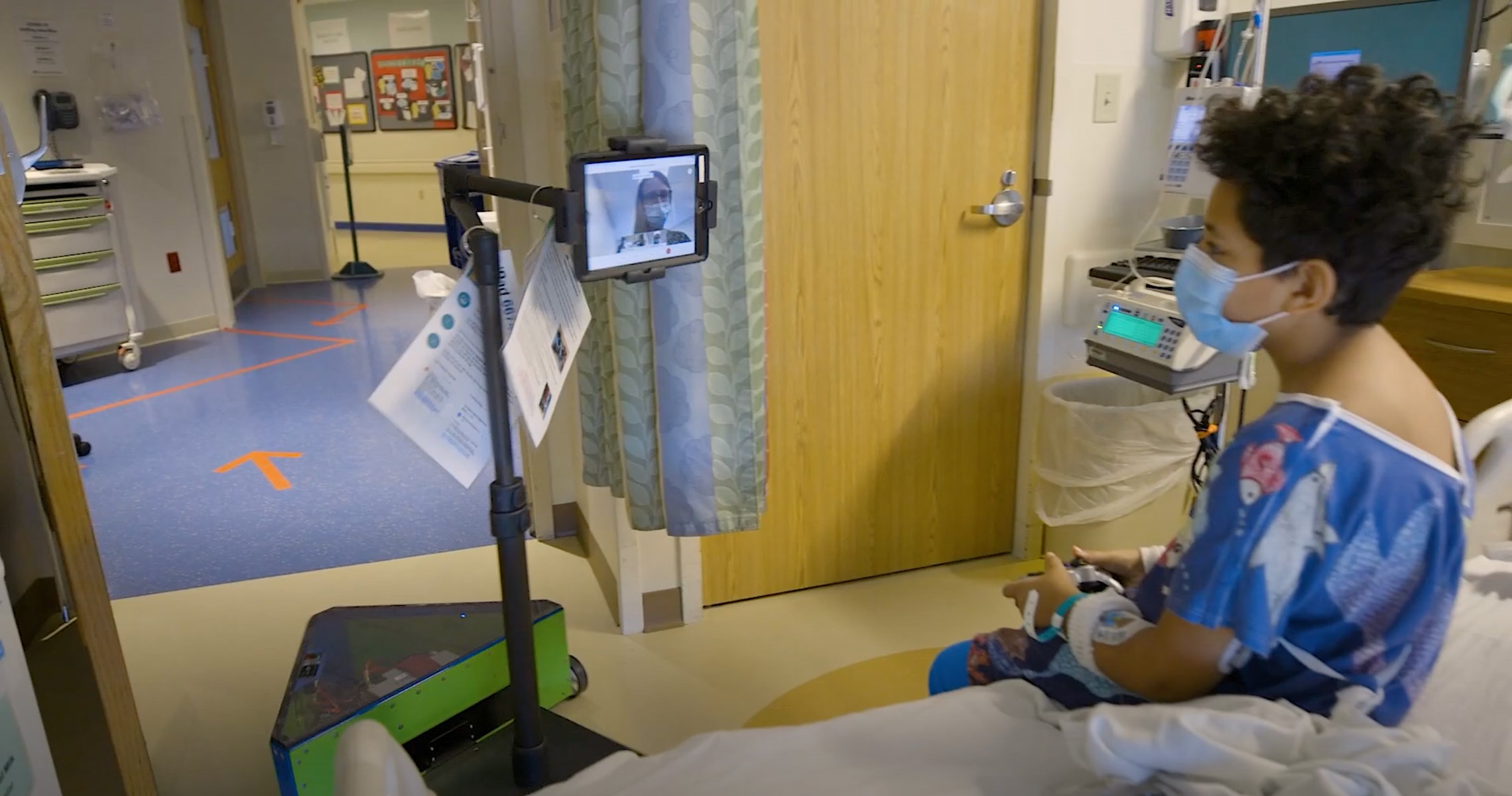At the height of the COVID-19 pandemic in spring 2020, Meredith MacMartin, MD, MS, Medical Director at the Jack Byrne Center for Palliative & Hospice Care at Dartmouth-Hitchcock (D-H), worried about COVID-19 patients struggling with isolation from loved ones.
Concurrently, Dartmouth-Hitchcock Medical Center (DHMC), like hospitals nationwide, was working to preserve Personal Protective Equipment (PPE) and sought creative ways of doing so while protecting patients and providers from exposure to the virus.
Patients were already provided iPads on mobile stands to visit with family members virtually or to meet with their care team, but bringing these tablets into patient rooms required at least one staff member to enter the room in PPE. This gave MacMartin the idea to develop a robot that could deliver the iPads-on-stands to patients’ rooms on its own, greatly reducing the risk for exposure and preserving PPE.
“As we were preparing for a possible surge in COVID-19 patients in palliative care, we kept coming back to how we could protect the ability of patients, families, and care teams to communicate with one another,” said MacMartin. “Keeping lines of communication open is critical to the emotional support for sick patients, but also to help the people caring for them to know and understand the patient, what’s important to them, and what their life is like outside the hospital – information that is especially important during discharge planning or when medical decisions must be made. I wanted to find a way to use technology to keep these lines of communication open.”
EDITORS NOTE: View a video of the robot in action here
MacMartin contacted an engineer friend, Rich Kaszeta, who is involved in robotics competitions. Kaszeta introduced her to James Cole-Henry, a mechanical engineer at Fujifilm Dimatix in Lebanon, and coach of the Hartford Area Career and Technology Center (HACTC) FIRST Robotics Team #95. Kaszeta, Cole-Henry, and the HACTC Robotics Team, known as the “Grasshoppers,” comprising a dozen students from Hartford (VT) High School, Hanover High School, Lebanon High School, Mascoma Regional High School and home schools, helped to design and create the robot.
The team developed and tested several prototypes, ultimately resulting in the final robot, which is 26 inches wide and about 19 inches long, and triangular-shaped to easily maneuver around tight spaces in patient rooms. Operated by a remote-control device that resembles a video game controller, the robot can move up to five feet per second depending, and features a strong magnetic “target” that can grab and release the metal stand holding the iPad once it’s positioned at the patient’s bedside. The battery-powered robot features flat surfaces and can be charged and powered on or off without opening it, minimizing surfaces that must be cleaned and disinfected between uses. The robot's design, bill of materials, and code are all open-source so that others may access the work done by this team.
“This was an extremely fast product development cycle, just like the FIRST Robotics Competitions we participate in every year,” said Cole-Henry. “The students, alumni, and coaches involved put in extra hours to get things done on time. The local companies that generously donated their time, equipment, and materials did so at great speed and with exceptional quality. Leading this group of determined and capable people was both fun and rewarding. I am proud to have been a part of it.”
In addition to Cole-Henry and the Grasshoppers, many people and organizations volunteered expertise, time and supplies to the robot project, including Fujifilm Dimatix, Progressive Manufacturing Inc., Race Metalsmiths Inc., and Grasshopper Machine Werks LLC. Others include Grasshoppers Coach Andrew Alvarenga; HACTC alumni Maxwell Porter and Raymond Gonzalez, and local volunteer Edward Bieszczad.
In addition to incorporating these robots into its inpatient telehealth equipment, with the recent increase in the pandemic, D-H Connected Care will be using iPads and telehealth carts in the D-H Emergency Department and at regional hospitals to augment care, support, and when needed, critical care consultation for patients with COVID-19.
PHOTO CAPTION: Developed through a collaborative effort with local engineers and volunteers for use with COVID-19 patients, Dartmouth-Hitchcock recently introduced remote-controlled robots to deliver iPads to patient bedsides for telehealth purposes and to help patients and loved ones stay connected while reducing patient and staff exposure and conserving personal protective equipment. Currently in use at Children’s Hospital at Dartmouth-Hitchcock, D-H will also utilize the robots in other areas of the hospital. Shown in photo: Noah Robinson, a patient at CHaD, visits with a doctor via an iPad that was delivered to his bedside via robot.

